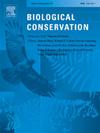超越学科孤岛的共存:人类与捕食者互动的五个维度分析
IF 4.9
1区 环境科学与生态学
Q1 BIODIVERSITY CONSERVATION
引用次数: 0
摘要
几十年来,了解人类与捕食者之间的相互作用一直是动物保护的中心目标,然而,许多先前的努力都是从单一案例研究的学科角度来应对这一挑战的。有必要进行更多跨学科和多地点的研究,以丰富我们对人类与非人类互动复杂性的理解,并设计出使其更愉快的方法。来自自然科学、社会科学和人文科学领域的学者参与了为期多年的CONVIVA“群落保护”研究项目,旨在通过对巴西美洲虎、芬兰狼、坦桑尼亚狮子和美国加州棕熊这四个不同的顶级捕食者的案例研究,促进物种共存、生物多样性和保护正义。在本文中,我们列出了两个关键贡献。首先,我们强调我们的项目如何在不同学科和观点之间创建迭代的、基于对话的反思,以告知研究问题、方法和分析单元,满足我们在文献中看到的关键需求。其次,我们将我们的合作超越学科孤岛,进入一个由五个相互关联的分析维度组成的新框架,该框架描述了人类与捕食者的相互作用,利用一系列镜头,包括一系列指导性问题。我们还展示了我们案例中的经验材料,涉及野生动物、环境、互动、制度和司法等方面。我们提出了我们的方法、框架和发现,并提出了集体反思,并邀请进行适应和进一步研究,以确定它们对其他环境和物种的适用性。本文章由计算机程序翻译,如有差异,请以英文原文为准。
Coexistence beyond disciplinary silos: Five dimensions of analysis for more convivial human-predator interactions
Understanding human-predator interactions has been a central goal of conservation for decades, yet many previous efforts have approached this challenge from disciplinary perspectives focused on single case studies. There is a need for more transdisciplinary and multi-sited research to enrich our understandings of the complexity of human-nonhuman interactions and to design ways to make them more convivial. The multi-year CONVIVA “convivial conservation” research project addressed this gap, involving scholars from natural sciences, social sciences and humanities to promote coexistence, biodiversity and justice in conservation across four diverse case studies of apex predators: jaguars in Brazil, wolves in Finland, lions in Tanzania, and brown bears in California, United States. In this article, we set out two key contributions. First, we highlight how our project created iterative, dialogue-based reflections amongst different disciplines and perspectives to inform research questions, methods and units of analysis, fulfilling what we see as a key need in the literature. Second, we operationalise our collaboration beyond disciplinary silos into a novel framework of five interconnected dimensions of analysis, that characterise human-predator interactions, drawing on a range of lenses and including a series of guiding questions. We also showcase empirical material from our cases across wildlife, environment, interactions, institutions and justice dimensions. We present our approach, framework and findings with collective reflections and an invitation for adaptation and further research on their suitability to other contexts and species.
求助全文
通过发布文献求助,成功后即可免费获取论文全文。
去求助
来源期刊

Biological Conservation
环境科学-环境科学
CiteScore
10.20
自引率
3.40%
发文量
295
审稿时长
61 days
期刊介绍:
Biological Conservation is an international leading journal in the discipline of conservation biology. The journal publishes articles spanning a diverse range of fields that contribute to the biological, sociological, and economic dimensions of conservation and natural resource management. The primary aim of Biological Conservation is the publication of high-quality papers that advance the science and practice of conservation, or which demonstrate the application of conservation principles for natural resource management and policy. Therefore it will be of interest to a broad international readership.
 求助内容:
求助内容: 应助结果提醒方式:
应助结果提醒方式:


